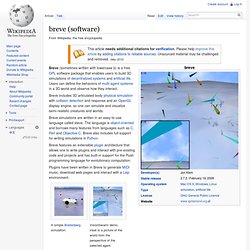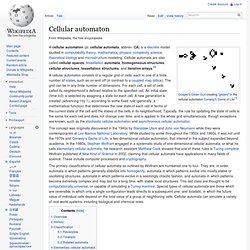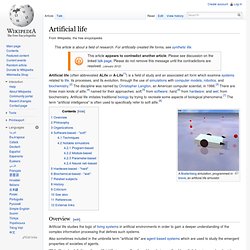

Future Collaborations with Mrinal. Breve (software) Breve (sometimes written with lowercase b) is a free, GPL software package that enables users to build 3D simulations of decentralized systems and artificial life.

Users can define the behaviors of multi-agent systems in a 3D world and observe how they interact. Breve includes 3D articulated body physical simulation with collision detection and response and an OpenGL display engine, so one can simulate and visualize semi-realistic creatures and worlds. VisionSwarm demo; inset is a picture of the world from the perspective of the selected agent. Digital organism. History[edit] Steen Rasmussen at Los Alamos National Laboratory took the idea from Core War one step further in his core world system by introducing a genetic algorithm that automatically wrote programs.

However, Rasmussen did not observe the evolution of complex and stable programs. It turned out that the programming language in which core world programs were written was very brittle, and more often than not mutations would completely destroy the functionality of a program. In 1996, Andy Pargellis created a Tierra-like system called Amoeba that evolved self-replication from a randomly seeded initial condition. See also[edit] Related topics and overviews[edit] Specific programs[edit] References[edit] Further reading[edit] O'Neill, B. (2003). Neural network. An artificial neural network is an interconnected group of nodes, akin to the vast network of neurons in a brain.

Here, each circular node represents an artificial neuron and an arrow represents a connection from the output of one neuron to the input of another. For example, a neural network for handwriting recognition is defined by a set of input neurons which may be activated by the pixels of an input image. After being weighted and transformed by a function (determined by the network's designer), the activations of these neurons are then passed on to other neurons.
This process is repeated until finally, an output neuron is activated. This determines which character was read. Like other machine learning methods - systems that learn from data - neural networks have been used to solve a wide variety of tasks that are hard to solve using ordinary rule-based programming, including computer vision and speech recognition. Background[edit] History[edit] Farley and Wesley A. Models[edit] or both. Cellular automaton. The concept was originally discovered in the 1940s by Stanislaw Ulam and John von Neumann while they were contemporaries at Los Alamos National Laboratory.

While studied by some throughout the 1950s and 1960s, it was not until the 1970s and Conway's Game of Life, a two-dimensional cellular automaton, that interest in the subject expanded beyond academia. In the 1980s, Stephen Wolfram engaged in a systematic study of one-dimensional cellular automata, or what he calls elementary cellular automata; his research assistant Matthew Cook showed that one of these rules is Turing-complete.
Wolfram published A New Kind of Science in 2002, claiming that cellular automata have applications in many fields of science. These include computer processors and cryptography. The primary classifications of cellular automata as outlined by Wolfram are numbered one to four. Overview[edit] A torus, a toroidal shape Cellular automata are often simulated on a finite grid rather than an infinite one. Artificial life. Artificial life (often abbreviated ALife or A-Life[1]) is a field of study and an associated art form which examine systems related to life, its processes, and its evolution, through the use of simulations with computer models, robotics, and biochemistry.[2] The discipline was named by Christopher Langton, an American computer scientist, in 1986.[3] There are three main kinds of alife,[4] named for their approaches: soft,[5] from software; hard,[6] from hardware; and wet, from biochemistry.

Artificial life imitates traditional biology by trying to recreate some aspects of biological phenomena.[7] The term "artificial intelligence" is often used to specifically refer to soft alife.[8] Overview[edit] Artificial life studies the logic of living systems in artificial environments in order to gain a deeper understanding of the complex information processing that defines such systems.
Applications of A-Life.